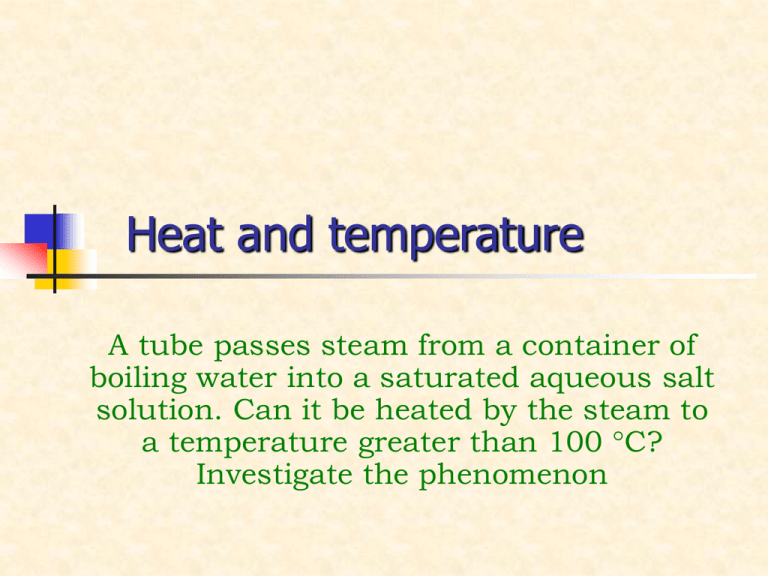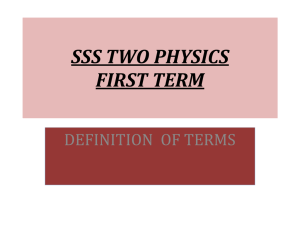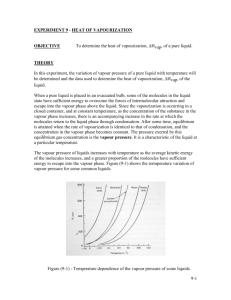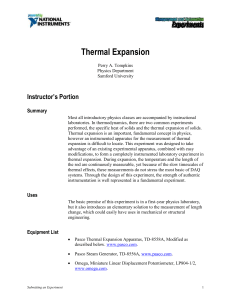Heat and temperature
advertisement

Heat and temperature A tube passes steam from a container of boiling water into a saturated aqueous salt solution. Can it be heated by the steam to a temperature greater than 100 °C? Investigate the phenomenon Research • Divided in phases: • Basic explanation • Achieving the effect: First apparatus Second apparatus • Measurement • Theoretical approach • Comparison Basic explanation • Changes when salt is dissolved in water: • Density (increases) • Vapour pressure (falls) • Boiling point (increases) Bubbles of water vapour at 100°C are able to condense in water – salt solution up to its boiling point solution heated to its boiling point by latent heat of condensation Basic explanation cont. • Boiling point increase: n T K b ms ε – number of particles the salt dissociates to Ke [K mol-1 kg] – ebulioscopic constant (for water 0,52) n – molar ms – solvent mass • For water and NaCl: T 5.3 K • For larger effect – different salts K2CO3 – 15.8 K Achieving the effect (apparatus 1) • An U - tube • Effect not achieved • Contact betwen bubble of vapour and solution too short • Container with solution too narrow • Turbulences appear Achieving the effect • Changes in second apparatus: • longer contact between vapour bubbles and solution • Wider tube (apparatus 2) Measuring • Measured: vapour and solution temperatures in time • Parameters: • Vapour mass flow rate (varied by heater power change) • Solution level in tube (held constant) • Most measurements with NaCl • K2CO3 used for demonstrating higher temperatures above 100°C Apparatus • Vaporisation chamber Erlenmayer tikvica Heater • Set of pipes and gauges • Testing tube to contain solution • Thermometer system • Electronic support Hardware Software Apparatus Thermometer 2 cont. Thermometer 3 Solution Gauge Thermometer 1 Heater Deionized water Apparatus cont. Apparatus - electronics Thermometer 1 Thermometer 2 Signal conditioning Multiplexer Thermometer 3 Motherboard ADC Computer Apparatus – electronics Multiplexer Motherboard cont. Theoretical approach • Goal: modeling the time evolution of solution temperature • Heat transfer – condensation/latent heat – losses • Two distionct regions: • Temperature far from solution boiling point (steam bubbles absorbed) • Temperature close to boiling point (bubbles mostly pass through) Theoretical approach cont. • Simplified heat transfer equation in the solution: M – initial solution mass M mcs dT dQd Ldm m – mass of condensed water cs – solution heat capacity T – temperature Qd – heat loss L – water latent heat of evaporation • Mass of condensed water – time dependent: dm mp dt Γ – number of bubbles in unit time (flow rate!) Δmp – mass of condensed steam per bubble Theoretical approach cont. • In Region 1 whole bubble absorbed: m p t 1 Mcs dT dQd Lm p dt M • In Region 2 bubble partially absorbed – complicated theory • Asymptotic behaviour determinable – bubble equation of motion Theoretical approach cont. • If losses are known, analytic solution in Region 1 possible • Losses: • Conduction through tube walls & air • Evaporation loss • Net losses – in first order linear in temperature: dQd T Ti dt Qd – loss Λ – constant T – solution temperature Ti – surroundings temperature Theoretical approach • Evidence – experimental: 3,7 temperature/100 [K] 3,6 3,5 3,4 3,3 3,2 exponential fit measurement 3,1 0 1000 2000 time [s] 3000 4000 5000 cont. Comparison 4,2 temperature/100 [K] 4,0 3,8 3,6 3,4 3,2 130 K theory solution steam 3,0 2,8 0 100 200 300 time [s] 400 500 600 -1 Comparison cont. 3,8 temperature/100 [K] 3,6 3,4 3,2 theory 80,5 W 115,5 W 150,4 W 224,0 W 3,0 2,8 0 500 1000 1500 time [s] 2000 2500 3000 Comparison cont. Additions Što ne znam na engleskom? Ako netko zna nek napiše Otapalo solvent Množina Disocirati Tikvica (elermayerova) Ventili ventils??? epruveta










